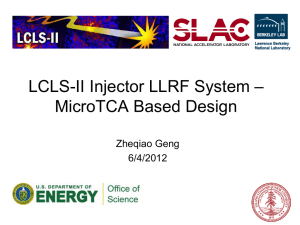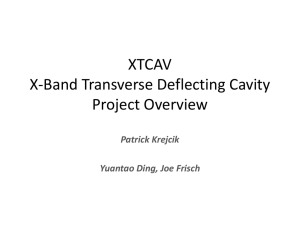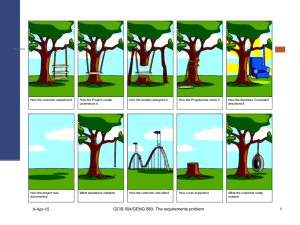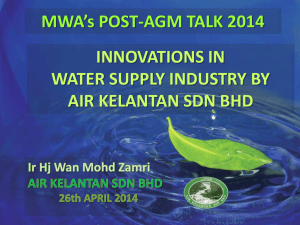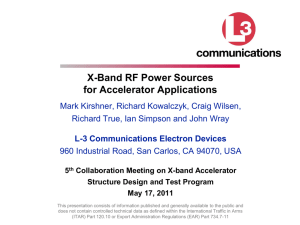Status of the mTCA LLRF Development
advertisement
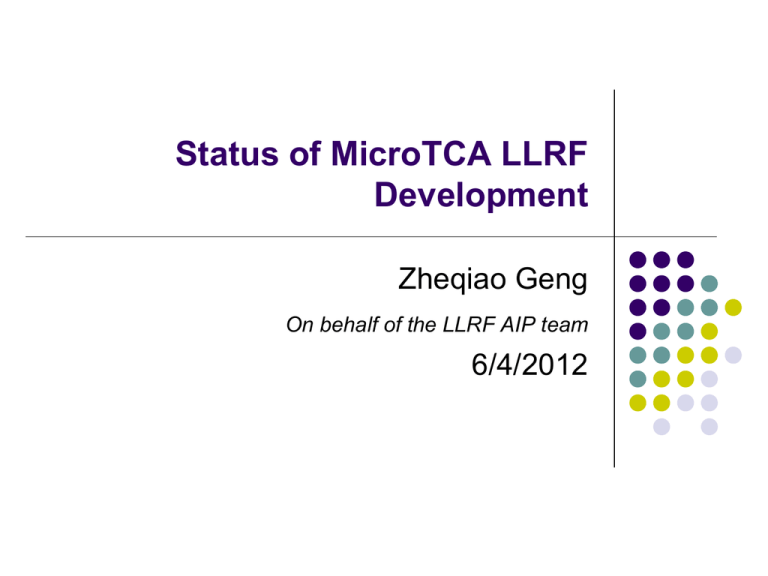
Status of MicroTCA LLRF Development Zheqiao Geng On behalf of the LLRF AIP team 6/4/2012 Outline History of LLRF at SLAC MicroTCA Based LLRF System Overview FPGA Firmware Design EPICS Software Design Applications for Operation System Tests Summary 2015/4/9 Zheqiao Geng, MicroTCA LLRF 2 History of LLRF at SLAC 2015/4/9 Zheqiao Geng, MicroTCA LLRF 3 SLAC Linac 2015/4/9 Zheqiao Geng, MicroTCA LLRF 4 Existing RF System of Linac 30 Sectors (LCLS uses the last 10 of them) Each sector contains of 8 klystrons and 1 sub-booster Every RF station has 2 racks for controls 2015/4/9 Zheqiao Geng, MicroTCA LLRF 5 WG & Cable Penetration to Tunnel Existing Linac Klystron Station RF Control, Monitoring, and Interlocking System IPA Chassis Controls RF Phase and Amplitude PIOP CAMAC Module Controls IPA, PAD, and MKSU. Interface to control system PAD Chassis Measures RF Phase and Amplitude MKSU Chassis Interlock and Control for Klystron SLED Support Systems Existing Controls Racks 7 PIOPs (4) Controls Upgrade Implementation PDU Timing 12-01-10 8 Controls Upgrade Implementation 12-01-10 9 LLRF for LCLS 2015/4/9 Several critical RF stations were upgraded for LCLS with newly designed Phase and Amplitude Detector (PAD), Phase and Amplitude Controller (PAC) and VME running EPICS The old IPA, MKSU and CAMAC system is kept (not shown in the diagram below) Zheqiao Geng, MicroTCA LLRF 10 LLRF for LCLS (cont.) 2015/4/9 PAD : Custom chassis with 4 channels of down mixers and ADCs PAC : Custom chassis with a DAC board and an I/Q modulator Zheqiao Geng, MicroTCA LLRF 11 Some Limitations of PAD/PAC A feedback control loop has to follow the chain of PAD-VME-PAC connected with Ethernet, the real-time performance is limited. It is not possible to do intra-pulse control (pulse width ~ 3 µs) Computation power of the Coldfire MCU used in PAD/PAC chassis is quite limited. One more Channel Access client connected to the EPICS software in the Coldfire MCU can significantly degrade its real-time performance One PAD chassis (2U or 3U) only contains 4 ADC channels. The density is too low to efficiently use the rack space Custom designed chassis is difficult to maintain The MicroTCA based LLRF system presented in this talk tends to upgrade the PAD/PAC system to be more compact, flexible, maintainable and reliable… 2015/4/9 Zheqiao Geng, MicroTCA LLRF 12 Overview of the MicroTCA Based LLRF System 2015/4/9 Zheqiao Geng, MicroTCA LLRF 13 PAD/PAC LLRF VS MicroTCA LLRF 2015/4/9 Zheqiao Geng, MicroTCA LLRF 14 RF Support Chassis 2015/4/9 Zheqiao Geng, MicroTCA LLRF 15 MicroTCA Crate 2015/4/9 Zheqiao Geng, MicroTCA LLRF 16 AMC Carrier + PMC EVR 2015/4/9 Zheqiao Geng, MicroTCA LLRF 17 AMC ADC Board – SIS8300 Struck SIS8300 Board 4 lane PCI Express 10 Channels 125 MS/s 16-bit ADC Two 16-bit DACs for Fast Feedback Implementation Twin SFP Card Cage for High Speed System Interconnects Virtex 5 FPGA The board is equivalent to the digital parts of 2.5 PADs + 1 PAC! 2015/4/9 Zheqiao Geng, MicroTCA LLRF 18 Summary of Hardware Architecture Compared to the PAD/PAC chassis, the MicroTCA based LLRF system uses commercial digital boards to reduce the R&D time MicroTCA system has much higher density of ADC/DAC channels. The system is more compact Compared to the PAD/PAC chassis, the digital hardware of the new design is installed in the MicroTCA crate. The boards are hot-swappable and easy to maintain To be improved (nice to have): 2015/4/9 An AMC EVR board will be introduced to route trigger signals via the backplane. ADC boards will take triggers from backplane to remove the trigger cables The RTM with S-band down mixers from DESY will be evaluated. The system can be more compact by moving the down mixers and up converter to the RTM board from the RF support chassis The klystron beam voltage conditioner board will be improved to directly measure the flattop of the voltage pulse by adding offset to the klystron beam voltage signal Zheqiao Geng, MicroTCA LLRF 19 FPGA Firmware (for SIS8300) Design 2015/4/9 Zheqiao Geng, MicroTCA LLRF 20 Major Requirements to the Firmware 2015/4/9 Intra-pulse phase feedback control Provide 64K sampling buffer for each ADC channel (10 channels) DAC can be used as an arbitrary waveform generator Exception detection and handling Zheqiao Geng, MicroTCA LLRF 21 Overview of the Firmware 2015/4/9 Zheqiao Geng, MicroTCA LLRF 22 Algorithm for Intra-pulse Phase Control Q Vector Rotation Demodulation Correction Q I I 2015/4/9 Q I Align the vector along the I axis so that Q components will be proportional to the phase jitter Phase error is estimated at the first part of the RF pulse and the correction is applied at the second part of the RF pulse (latency < 1 µs) Zheqiao Geng, MicroTCA LLRF 23 ADC Data Acquisition Spectrum by FFT 64 K samples from ADC2 (SNR = 77 dBFS) 2015/4/9 Allow up to 64K point data acquisition for ADC SNR calculation Zheqiao Geng, MicroTCA LLRF 24 DAC Waveform Generation Waveforms Generated by 2048point Buffers (triggered output) Waveforms Generated by 2048point Buffers (CW output) Specify arbitrary I/Q waveforms in two 2048-point buffers for two DACs Allow CW output regardless of trigger Example: In-phase and Quadrature waveforms for single side band modulation 2015/4/9 Zheqiao Geng, MicroTCA LLRF 25 RF System Simulator Simulated Klystron Output (25.5 MHz IF) Input to the RF System Simulator Simulate the klystron output and SLED output The simulator can be used to test most of the functions in the lab Simulated SLED Output (25.5 MHz IF) 2015/4/9 Zheqiao Geng, MicroTCA LLRF 26 EDM Panel for Firmware Control 2015/4/9 Zheqiao Geng, MicroTCA LLRF 27 Summary of Firmware Design MicroTCA based LLRF system connects ADCs and DACs to the same FPGA to enable the intra-pulse control The powerful FPGA is used to implement most of the complex real-time functions to relax the CPU load. 360 Hz operation or multi-bunches operation can be well supported PCI Express links the FPGA and CPU to enable faster data transfer which improves the data acquisition capability To be improved (basic): The firmware will be extended to be general and configurable for all RF stations (CW control, Laser control, RF Gun control, X-band and S-band klystron control) Intra-pulse phase feedback will be upgraded for both amplitude and phase control. I/Q control scheme will be used To be Improved (nice to have): 2015/4/9 Improve the intra-pulse control refer to the klystron high voltage jitters if they have stronger correlations Improve the up conversion algorithm to reduce the non-linearity of the phase and amplitude actuation Zheqiao Geng, MicroTCA LLRF 28 EPICS Software Design 2015/4/9 Zheqiao Geng, MicroTCA LLRF 29 Software Architecture 2015/4/9 Zheqiao Geng, MicroTCA LLRF 30 EDM Panels – RF Station Top 2015/4/9 Zheqiao Geng, MicroTCA LLRF 31 EDM Panels – Pulse-pulse Phase Control 2015/4/9 Zheqiao Geng, MicroTCA LLRF 32 EDM Panels – LLRF Timing Settings 2015/4/9 Zheqiao Geng, MicroTCA LLRF 33 EDM Panels – RF Synchronous DAQ 2015/4/9 Save all phase and amplitude values of the RF signals for the same RF pulse synchronously up to 65536 pulses Save all waveforms for the same RF pulse synchronously up to 2048 pulses Zheqiao Geng, MicroTCA LLRF 34 EDM Panels – RF Waveforms 2015/4/9 Zheqiao Geng, MicroTCA LLRF 35 Summary of Software Design PAD/PAC based LLRF system has software pieces in PAD CPU, PAC CPU and VME CPU, they communicate with each other via UDP. The architecture is complex and difficult to maintain. The computation power of these CPUs are quite limited MicroTCA based LLRF system has one much more powerful CPU. Real-time Linux OS will be used and it is much more flexible to be adapted to the newest multi-core CPUs MicroTCA software is compiled to a single IOC process so the number of maintenance points is reduced Data and waveforms can be saved at 120 Hz for diagnostics. Later this function can be synchronized by Timing System for all RF stations so that the behavior of the entire machine can be analyzed within one RF pulse Software architecture is more modular and understandable To be improved (basic): 2015/4/9 Software should be improved to fit the extended firmware MicroTCA infrastructure (such as software development tools, EPICS base, boot up tools) needs to be improved. This topic will be covered by Charlie Xu’s talk Zheqiao Geng, MicroTCA LLRF 36 LLRF Applications 2015/4/9 Zheqiao Geng, MicroTCA LLRF 37 LLRF Applications Examples of Applications for A RF Station Measure the klystron energy no-load Measure klystron saturation curve Measure the beam phase with beam induced signal Calibration of the imbalance of the I/Q modulator and DAC offset Loop phase correction for intra-pulse feedback control Intra-pulse feedback gain optimization DAC waveform generation for single side band up-conversion Set klystron mode to ACC or standby Most of the applications already exist for the old RF stations. The new LLRF software will inherit the existing algorithms and codes 2015/4/9 Zheqiao Geng, MicroTCA LLRF 38 System Test 2015/4/9 Zheqiao Geng, MicroTCA LLRF 39 ADC Noise Measurement 510-04516D 100MHz 25MHz 1/4 Freq Divider 4 I SIS8300 MicroRTM 100MHz CH0 CH1 CH2 CH3 CH4 CH5 CH6 CH7 CH8 CH9 CLK2 CLK1 CLK0 6570 -1.906 6560 -1.907 6550 -1.908 6540 -1.909 6530 0 2 4 6 8 -1.91 Q x 10 0 2 4 6 4 Signal to Noise Ratio (dBFS) 4 2.019 x 10 Amp x 10 Pha/deg -70.9 ADC0 ADC1 ADC2 ADC3 ADC4 ADC5 ADC6 ADC7 ADC8 ADC9 2.018 -70.95 At Lab 77.4 78.6 78.2 79.4 78.2 78.8 77.0 78.8 79.1 79.2 2.017 -71 At 28-2 76.1 76.7 76.7 77.2 76.5 77.4 76.7 77.6 77.4 77.4 2.016 -71.05 2.015 Crosstalk Matrix (dB) 0 2 4 6 8 -71.1 0 2 4 6 4 ADC1 ADC2 ADC3 ADC4 ADC5 ADC6 ADC7 ADC8 ADC9 ADC0 0 88.9 87 97.3 95.2 111.6 106.2 112.2 103.5 112.3 ADC1 82.7 0 87.1 98.5 97 105 108.5 112.9 104.6 108.9 x 10 0 Data Noise Floor Signal Level -20 82.3 84.1 0 86.1 87 98.6 96.8 113 104.4 112.2 ADC3 95.8 94.7 81.2 0 97.1 98.5 98.9 109.8 103.9 111.5 ADC4 91.5 93.4 83.8 97.7 0 85.5 85.1 98.6 98.6 109.9 ADC5 99.2 101.1 95.1 94.9 81.3 0 92.5 101.1 100.4 111.8 ADC6 100.2 101.4 94.3 93.6 81 88.5 0 87.2 88.9 107.3 ADC7 98.9 102.4 103.5 102.4 94.9 97.8 81.7 0 84.7 109.7 ADC8 100.5 102.1 105.4 104.6 96 94.7 84.3 81.1 0 95.2 ADC9 99.3 102.3 104.8 104.8 100.9 106.4 106.5 101.5 92.4 0 -40 Amplitude / dBFS ADC2 8 4 x 10 ADC0 8 4 x 10 -60 -80 -100 2015/4/9 Zheqiao Geng, MicroTCA LLRF -120 -140 0 5 10 15 20 25 30 Frequency / MHz 35 40 45 40 50 Phase and Amplitude Measurement Noise With a -1dBFS 25.5 MHz IF input and 257 fs clock jitter, the measurement noises (in full bandwidth of ADC) are expected to be: 119 MHz clock jitter: 257 fs integrated from 10 Hz to 40 MHz 2015/4/9 Zheqiao Geng, MicroTCA LLRF Phase : 0.01 deg RMS Amplitude: 0.02 % RMS Considering the bandwidth of the RF system in the view of the beam (~1.2 MHz), the measurement noises will meet the LCLS-II requirements (0.07 deg RMS phase jitter and 0.06 % RMS amplitude jitter for the most critical RF station of L1S) 41 Installation at LI28-2 SSSB RF Support Chassis MicroTCA Crate MKSUII 2015/4/9 Zheqiao Geng, MicroTCA LLRF 42 System Test at LCLS Linac (LI28-2) - RF Signal Measurement 2015/4/9 Zheqiao Geng, MicroTCA LLRF 43 RF Reference Signal 2015/4/9 Zheqiao Geng, MicroTCA LLRF 44 I/Q Modulator Output Signal 2015/4/9 Zheqiao Geng, MicroTCA LLRF 45 Klystron Drive Signal 2015/4/9 Zheqiao Geng, MicroTCA LLRF 46 Klystron Output Signal 2015/4/9 Zheqiao Geng, MicroTCA LLRF 47 SLED Output Signal 2015/4/9 Zheqiao Geng, MicroTCA LLRF 48 System Test at LCLS Linac (LI28-2) - Reference Tracking 2015/4/9 Zheqiao Geng, MicroTCA LLRF 49 Reference Tracking Subtract the phase of the reference signal from other RF signal phases Remove the common mode error caused by the RF detectors experiencing the same temperature fluctuations Remove the phase jump caused by the clock re-synchronization Reference signal 59.5 Reference Phase Phase / deg 59.4 59.3 59.2 59.1 59 0 5000 10000 15000 10000 15000 10000 15000 Klystron output signal Phase / deg 57 Klystron Output Phase 56 55 54 53 0 5000 SLED output signal 104.5 SLED Output Phase Phase / deg 104 103.5 103 102.5 102 0 5000 Time / s 2015/4/9 Zheqiao Geng, MicroTCA LLRF 50 System Test at LCLS Linac (LI28-2) - Pulse-pulse Feedback 2015/4/9 Zheqiao Geng, MicroTCA LLRF 51 Long Term Stability with Feedback SLED phase without feedback Phase / deg 31 30.5 30 29.5 29 0 1000 2000 0 1000 2000 3000 4000 5000 Time / s SLED phase with feedback 6000 7000 8000 6000 7000 8000 Phase / deg 31 30.5 30 29.5 29 3000 4000 Time / s 5000 2-hour phase measurement 2015/4/9 Zheqiao Geng, MicroTCA LLRF 52 System Test at LCLS Linac (LI28-2) - Intra-pulse Feedback 2015/4/9 Zheqiao Geng, MicroTCA LLRF 53 Intra-pulse Feedback Phase error is estimated at the first part of the RF pulse and the correction is applied at the second part of the RF pulse Loop delay should < 1 µs Phase jitter of different parts of the RF pulse should be correlated The entire loop delay is ~ 600 ns, quite promising for intrapulse feedback. 2015/4/9 Zheqiao Geng, MicroTCA LLRF 54 Phase Jitter Correlation Correlation coefficient of the phase jitter between different parts of the RF pulse ~ 0.3-0.4 2015/4/9 Zheqiao Geng, MicroTCA LLRF 55 Intra-pulse Feedback Gain Sweeping Phase Jitter / deg Feedback Gain Effects of the intra-pulse feedback on the beam can only be tested at the sensitive RF stations (like L1S) Correlation of the phase jitters of different parts of the RF pulse is not so strong How about the correlation between phase jitter and the klystron high voltage? 2015/4/9 Zheqiao Geng, MicroTCA LLRF 56 System Test at LCLS Linac (LI28-2) - Intra-pulse phase slope compensation 2015/4/9 Zheqiao Geng, MicroTCA LLRF 57 Motivations 2015/4/9 At rising edge of the klystron signal, the phase changes > 100 deg, which will lower the efficiency to fill the SLED cavities Klystron signal after PSK has a phase change > 60 degree, which will lower the integrated E field seen by the beam Idea: Remove the phase slope with feed forward to possibly increase the energy gain from the klystron Zheqiao Geng, MicroTCA LLRF 58 Phase Slope Compensation with Feed Forward 2015/4/9 Zheqiao Geng, MicroTCA LLRF 59 SLED Amplitude with Feed Forward Iterations Amplitude of SLED output can be increased by ~ 3 % Note: There is still 10 degree phase change at the SLED output pulse during the part that interacts with the beam! The MicroTCA based LLRF system provides a very powerful platform to implement the new ideas from physicists 2015/4/9 Zheqiao Geng, MicroTCA LLRF 60 System Test at LCLS Linac (LI28-2) - Phasing the klystron 2015/4/9 Zheqiao Geng, MicroTCA LLRF 61 Phasing the Klystron with Matlab Without phase feed forward control 2015/4/9 With 50 iterations of phase feed forward control Need further measurement to clarify if we can really increase the energy gain or not! Zheqiao Geng, MicroTCA LLRF 62 More Tests Need to be Done 2015/4/9 Intra-pulse I/Q control need to be tested at critical RF stations like L1S before the first bunch compressor. The effects of the intra-pulse control can be examined by monitoring the beam stability Measurement of beam induced signal need to be done at LI28-2. To do this test, the klystron need to be in standby state Correlation between RF amplitude/phase jitters and klystron high voltage jitter need to be tested. This will tell us if we can use the klystron high voltage jitter for intra-pulse feedback. As mentioned before, a new klystron beam voltage conditioner board need to be designed More tests need to be done to check if the intra-pulse phase slope compensation can increase the energy gain or not Zheqiao Geng, MicroTCA LLRF 63 Summary 2015/4/9 Zheqiao Geng, MicroTCA LLRF 64 Summary of MicroTCA System 2015/4/9 MicroTCA introduces intra-pulse control to reduce fast jitters MicroTCA system uses PCI express for faster data acquisition which enables to save the RF waveforms at 120 Hz or even at 360 Hz MicroTCA system uses more powerful FPGA and CPU which enables to upgrade the system for 360 Hz or multi-bunch operation without changing the hardware MicroTCA system contains more ADC channels in a single board which enables to implement the reference tracking to remove the phase jump problem in digital I/Q demodulation algorithm The PAD/PAC system uses Coldfire MCU which is a bottleneck for real-time performance. The PAD-VME-PAC chain is connected with Ethernet and it is not possible to perform intra-pulse control. 120 Hz waveform saving is poorly supported as well Zheqiao Geng, MicroTCA LLRF 65 Summary of MicroTCA System (cont’d) 2015/4/9 MicroTCA has better upgradability: overhead in data transfer speed (PCI Express) and computation power (FPGA + multi-core CPU) MicroTCA has better maintainability: hot-swappable – reducing repair time – more availability MicroTCA has better reliability – simpler and more compact system structure; redundant MCH and power supply MicroTCA has better platform management – IPMI MicroTCA is a new platform which needs more development efforts Cost is relatively high due to small market Zheqiao Geng, MicroTCA LLRF 66 Thank you! 2015/4/9 Zheqiao Geng, MicroTCA LLRF 67 Backup Slides 2015/4/9 Zheqiao Geng, MicroTCA LLRF 68 Phase and Amplitude Actuation Noise I/Q modulator Input Jitters: Phase 0.083 deg RMS, Amplitude 0.01% I/Q modulator Output Jitters: Phase 0.074 deg RMS, Amplitude 0.03% The phase and amplitude actuation does not introduce extra noise (or at least neglectable) 2015/4/9 Zheqiao Geng, MicroTCA LLRF 69
